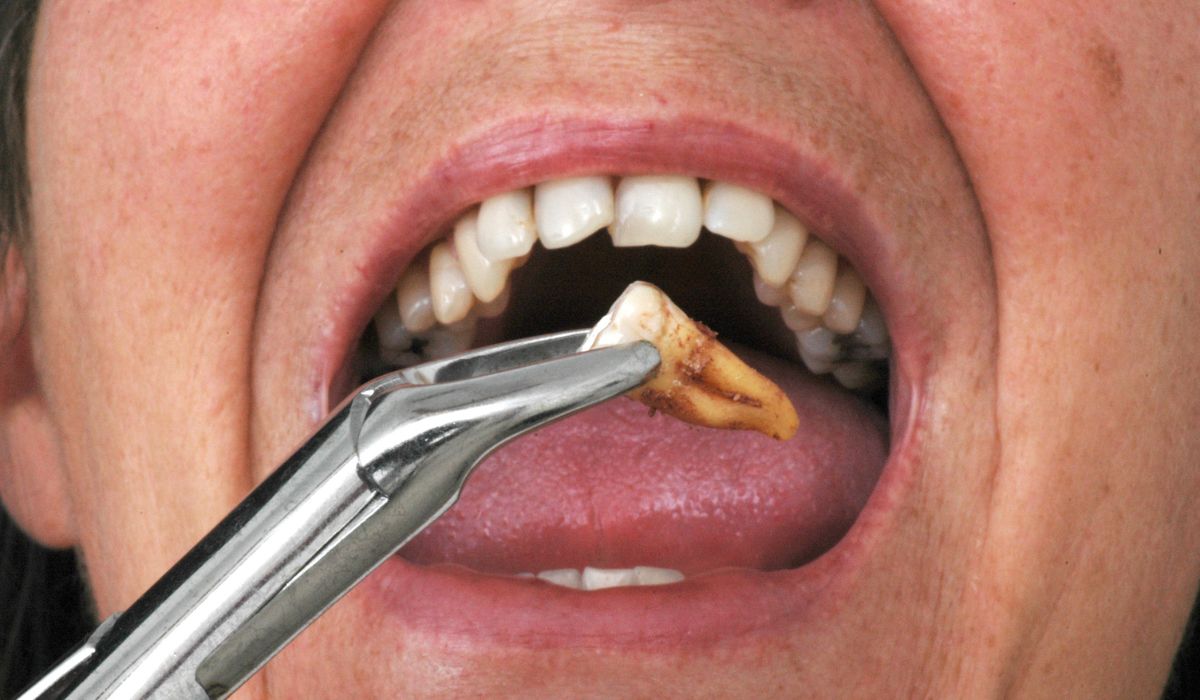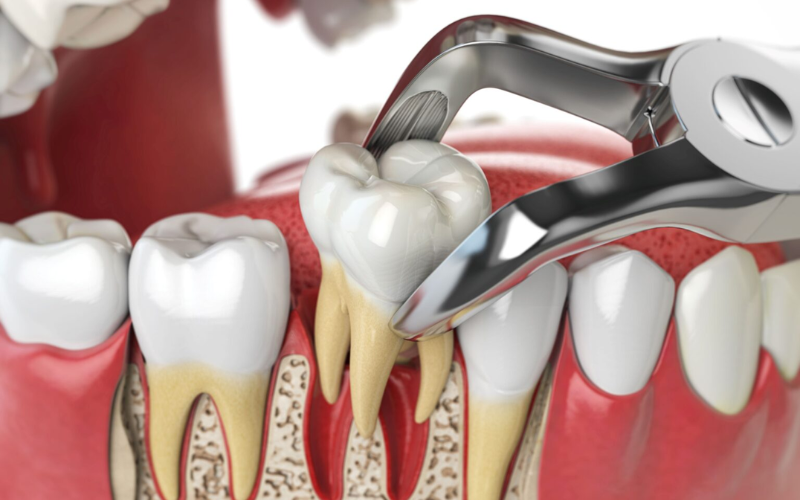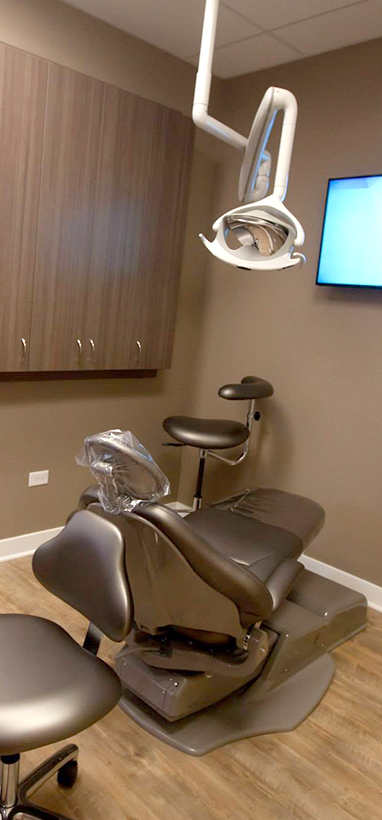1516 Legacy Cir, Naperville, IL 60563
How to Deal with Bleeding After a Tooth Extraction

Tooth extractions are a common dental procedure, and while generally safe, a little bleeding is to be expected afterward. While the sight of blood might be alarming, it’s usually a normal part of the healing process. However, knowing how to manage this bleeding effectively can make a significant difference in your comfort level during recovery. This blog post will equip you with the knowledge to tackle post-extraction bleeding like a pro. We’ll delve into the causes of bleeding, explore effective methods to control it and provide tips for a smooth and speedy recovery.
Why Does Bleeding Happen After a Tooth Extraction?
Bleeding after a tooth extraction is a common occurrence, and understanding why it happens can help ease any anxieties you might have. During a tooth extraction, your dentist disrupts blood vessels and tissues surrounding the tooth socket. This disruption naturally triggers bleeding as part of your body’s initial response. The good news is your body has a remarkable built-in clotting mechanism designed to stop the bleeding and kickstart the healing process. This clotting mechanism involves tiny blood particles called platelets that clump together to form a seal over the extraction site. Here’s a closer look at some factors that can influence how much you bleed after a tooth extraction:
Complexity of the Extraction
Simple extractions of single, visible teeth involve minimal disruption and typically cause less bleeding. On the other hand, complex procedures involving impacted wisdom teeth or teeth with deeply rooted or multiple roots can cause more bleeding. This is because they require more extensive maneuvering and cause greater disruption to the surrounding tissues.
Your Overall Health
Certain medical conditions can affect your body’s clotting ability and prolong bleeding after a tooth extraction. These may include uncontrolled diabetes, hemophilia, or other blood clotting disorders. Medications, particularly blood thinners like aspirin or warfarin, can also interfere with clotting and need to be discussed with your dentist beforehand.
Age
Healing is often faster in younger individuals. Their bodies are more efficient at clotting and repairing tissues, which can lead to a quicker reduction in bleeding after a tooth extraction.
How Much Bleeding is Normal?
Following a tooth extraction, it’s natural to experience some bleeding. This occurs because blood vessels are severed during the procedure. Here’s what to expect:
- Slight oozing: In the initial hours after your extraction, you’ll likely experience a small amount of blood-tinged saliva. This is perfectly normal and should subside gradually over time.
- Bleeding for the first 24 hours: A reddish tinge in your saliva mixed with blood is expected for the first day. This doesn’t necessarily indicate excessive bleeding. You might also experience a metallic taste in your mouth due to the blood.
- Soaked gauze pad: Your dentist will likely provide you with gauze pads to apply pressure to the extraction site. If the gauze pad becomes soaked with blood within the first hour, don’t panic. This is still within the normal range. Replace the gauze pad with a fresh one and continue applying gentle pressure.
Warning Signs of Excessive Bleeding
While some bleeding is expected, some situations require immediate attention from your dentist:
- Bright red blood continuously flowing: If you experience a steady flow of bright red blood that soaks through gauze pads quickly (within 15 minutes) and doesn’t subside with applied pressure, contact your dentist right away.
- Bleeding that persists beyond 24 hours: While some minor bleeding might linger for a day, persistent bleeding that continues heavily after 24 hours is a cause for concern.
- Large blood clots: If you dislodge a large blood clot from the extraction site, it can cause renewed bleeding. Report this to your dentist.
Effective Methods to Control Bleeding
While some minor bleeding is expected after dental extraction, here’s a comprehensive guide packed with practical strategies to minimize it and promote faster healing:
Direct Pressure with Gauze Pads
- Gear Up: Your dentist Naperville will likely send you home with sterile gauze pads. Wash your hands thoroughly with soap and warm water before handling the gauze.
- Targeted Application: Locate the extraction site and gently place a clean, damp gauze pad directly on it.
- Bite Down Firmly: Apply firm but comfortable pressure by biting down on the gauze pad for 30-45 minutes. This sustained pressure helps form a clot, which is the body’s natural way to plug the bleeding vessel.
- Gentle Replacements: After the allotted time, carefully remove the gauze pad. If bleeding persists, replace it with a fresh, damp gauze pad. Be gentle during this process to avoid dislodging any forming clots, which can prolong bleeding.
Ice Pack Magic for Reduced Blood Flow
- Cold Therapy: Prepare an ice pack by wrapping it in a thin towel or cloth to prevent direct skin contact.
- Targeted Relief: Apply the ice pack to the outside of your cheek, near the extraction site, for 15-minute intervals. The cold temperature constricts blood vessels, reducing blood flow to the area and minimizing bleeding.
- Repeating Relief: After each 15-minute application, take a 15-minute break before repeating with the ice pack.
Tea Time with a Twist: Harnessing Natural Tannins
- Brew for Benefits: Black or green tea is your secret weapon here. Steep a tea bag in warm water for a few minutes, then allow it to cool slightly until it’s lukewarm.
- Astringent Power: The natural tannins present in black and green tea have astringent properties that help shrink tissues and promote clotting.
- Soothing Application: Place the cooled, damp tea bag directly on the extraction site and gently bite down for 20-30 minutes. The combination of pressure and tannins can be very effective in controlling bleeding.
Bonus Tips for a Speedy Recovery
- Rest and Relaxation: Take it easy for the next 24-48 hours after your extraction. Avoid strenuous activity that could increase blood pressure and dislodge the clot.
- Elevation is Key: When resting, elevate your head with extra pillows while sleeping to help reduce swelling and bleeding.
- Mindful Munching: Stick to soft foods like yogurt, applesauce, or mashed potatoes for the first few days after your extraction. Avoid using straws or consuming hot beverages, as these can dislodge the clot.
- Oral Hygiene Matters: Maintain good oral hygiene by gently rinsing your mouth with cool salt water. Take half a teaspoon of salt in a glass of warm water several times a day. This helps remove food particles and promotes healing.
When to Call Your Dentist
Following a dental procedure, it’s normal to experience some minor discomfort and bleeding. However, some situations indicate a potential complication and require a call to your dentist. Here’s a breakdown of signs to watch for:
- Excessive Bleeding: While some initial bleeding is expected, especially after procedures like tooth extractions, the amount should be manageable. If the bleeding soaks through multiple gauze pads within 30 minutes, it’s a cause for concern.
- Unrelenting Bleeding: Even with consistent pressure applied with gauze pads, bleeding that continues for several hours beyond 2-3 hours is a sign something might not be clotting properly. Contact your dentist for further instructions.
- Worsening Pain and Swelling: Some pain and swelling are normal after dental procedures, but they should gradually improve over time. If the pain worsens significantly or the swelling becomes more pronounced, call your dentist right away!
- Signs of Infection: Be on the lookout for symptoms that suggest an infection, such as redness, tenderness, or pus around the surgical site. A fever (usually above 100°F) can also be a sign of infection and warrants a call to your dentist.
Remember, a little post-extraction bleeding is a normal part of the healing process. By following these tips, you can conquer the bleeding and emerge victorious with a healthy, happy smile. If you have any concerns, don’t hesitate to reach out to your dental practices. They are your champions on the path to a speedy recovery!










